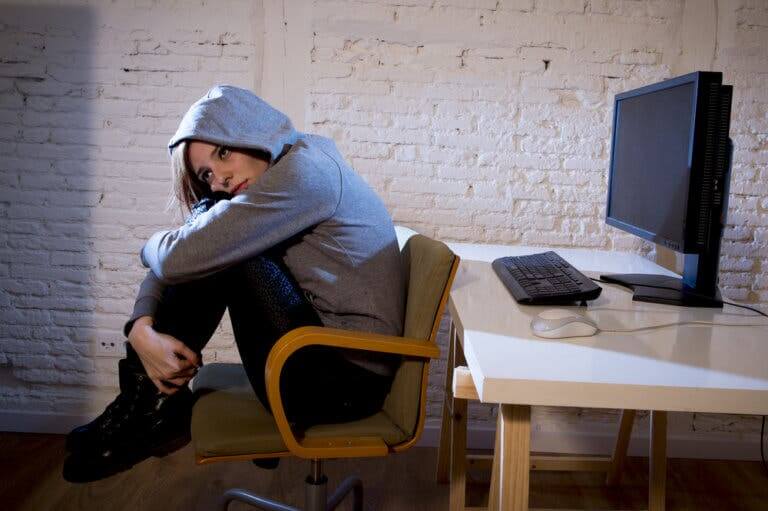Dangerous Trends for Teens on Social Networks

Social networks and the sometimes dangerous trends that circulate on them have a great impact on the lives of adolescents.
13 Reasons Why is a Netflix series that tells the sad story of a teenager who has decided to take her own life, and explains the 13 reasons why she has done so.
This series describes the power and influence of social networking, bullying, and the challenges teens face every day, both at school and at home.
Social networks can be a force for good, but they can also be extremely dangerous. There are several trends in social networking among teens that parents should know about in order to protect their children.
Dangerous trends in social media
Inappropriate photos
These days, there are so many apps and services that teens can use to communicate. All it takes is an inappropriate picture or an unpleasant statement for a life to change forever. Teens can feel a strong desire to fit in and feel accepted, and sometimes they forget the potential that a photo or text can have to go viral.
Parents should leave the door open for communication with their teen. Try to tune in to your teenager and let them talk if they seem ready. Creating a sense of openness and a non-judgmental approach will make it easier for your teen to feel able to open up.
In addition, when parents show that there aren’t any issues that are taboo and that they’re happy to talk about all of them, showing themselves to be vulnerable, then teens sit up and take notice. Our job is simply to keep quiet and listen.

However, if your teen refuses to open up and you feel that their behavior shouldn’t be ignored, then talk to a therapist about what you should do. Don’t be afraid to insist and ask tough questions. General therapists or school therapists have a lot to offer and have a lot of resources at their disposal.
On top of that, most people don’t realize that many school therapists are taught therapeutically to counsel people. Counselors offer academic support, individual counseling, and parental counseling. Ideally, you should start with a one-on-one meeting to understand the counselor-student relationship.
Dangerous challenges on social networks
Sites like YouTube, Facebook, and Instagram have the potential to reach large audiences. This is excellent if the information is secure and appropriate, but that isn’t always the case. It’s a sad fact of life that scary, tasteless and nasty videos attract large audiences. Teenagers are tempted to watch them, but the danger starts when they actually start to enjoy them.
There are two challenges on YouTube that have proven to be quite dangerous. One is called “The Duct Tape Challenge,” in which a person is stuck to a pole or a piece of furniture and then has to try to escape.
In one particular case, a teenager fell and hit his eye socket, causing a brain aneurysm. He was in critical condition in 2016. Showing your teenager this story may make them think.
Another challenge was swallowing a large amount of cinnamon without water. Doesn’t sound too scary, does it? Think again: a four-year-old boy thought he would try it and ended up choking to death in 2015. Cinnamon can cause life-threatening respiratory problems.

There’s also a challenge on Facebook where participants use a “light” strangulation to reduce their oxygen intake until they pass out. Apparently, this causes a brief high. However, if it’s done incorrectly, it can be fatal. It’s far too dangerous and teens should simply be made aware so that they don’t play these games and potentially harm themselves, either physically or psychologically.
Dangerous trends in social media: would your child do it?
Perhaps, as a parent, you think that your child would never do something like this, but you can never be sure. Instead of ignoring these trends, it’s best to talk to your kids about them and explain the potentially serious consequences of following them. Make them aware of the risks so that when they see these latest trends on social networks they don’t follow them.
Social networks can bring many good things, but they’re also a tool for evil. For this reason, we need to be informed in order to help our teens think critically about these things.
Social networks and the sometimes dangerous trends that circulate on them have a great impact on the lives of adolescents.
13 Reasons Why is a Netflix series that tells the sad story of a teenager who has decided to take her own life, and explains the 13 reasons why she has done so.
This series describes the power and influence of social networking, bullying, and the challenges teens face every day, both at school and at home.
Social networks can be a force for good, but they can also be extremely dangerous. There are several trends in social networking among teens that parents should know about in order to protect their children.
Dangerous trends in social media
Inappropriate photos
These days, there are so many apps and services that teens can use to communicate. All it takes is an inappropriate picture or an unpleasant statement for a life to change forever. Teens can feel a strong desire to fit in and feel accepted, and sometimes they forget the potential that a photo or text can have to go viral.
Parents should leave the door open for communication with their teen. Try to tune in to your teenager and let them talk if they seem ready. Creating a sense of openness and a non-judgmental approach will make it easier for your teen to feel able to open up.
In addition, when parents show that there aren’t any issues that are taboo and that they’re happy to talk about all of them, showing themselves to be vulnerable, then teens sit up and take notice. Our job is simply to keep quiet and listen.

However, if your teen refuses to open up and you feel that their behavior shouldn’t be ignored, then talk to a therapist about what you should do. Don’t be afraid to insist and ask tough questions. General therapists or school therapists have a lot to offer and have a lot of resources at their disposal.
On top of that, most people don’t realize that many school therapists are taught therapeutically to counsel people. Counselors offer academic support, individual counseling, and parental counseling. Ideally, you should start with a one-on-one meeting to understand the counselor-student relationship.
Dangerous challenges on social networks
Sites like YouTube, Facebook, and Instagram have the potential to reach large audiences. This is excellent if the information is secure and appropriate, but that isn’t always the case. It’s a sad fact of life that scary, tasteless and nasty videos attract large audiences. Teenagers are tempted to watch them, but the danger starts when they actually start to enjoy them.
There are two challenges on YouTube that have proven to be quite dangerous. One is called “The Duct Tape Challenge,” in which a person is stuck to a pole or a piece of furniture and then has to try to escape.
In one particular case, a teenager fell and hit his eye socket, causing a brain aneurysm. He was in critical condition in 2016. Showing your teenager this story may make them think.
Another challenge was swallowing a large amount of cinnamon without water. Doesn’t sound too scary, does it? Think again: a four-year-old boy thought he would try it and ended up choking to death in 2015. Cinnamon can cause life-threatening respiratory problems.

There’s also a challenge on Facebook where participants use a “light” strangulation to reduce their oxygen intake until they pass out. Apparently, this causes a brief high. However, if it’s done incorrectly, it can be fatal. It’s far too dangerous and teens should simply be made aware so that they don’t play these games and potentially harm themselves, either physically or psychologically.
Dangerous trends in social media: would your child do it?
Perhaps, as a parent, you think that your child would never do something like this, but you can never be sure. Instead of ignoring these trends, it’s best to talk to your kids about them and explain the potentially serious consequences of following them. Make them aware of the risks so that when they see these latest trends on social networks they don’t follow them.
Social networks can bring many good things, but they’re also a tool for evil. For this reason, we need to be informed in order to help our teens think critically about these things.
This text is provided for informational purposes only and does not replace consultation with a professional. If in doubt, consult your specialist.








